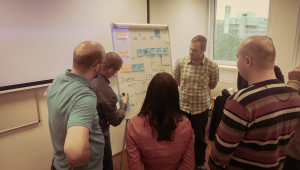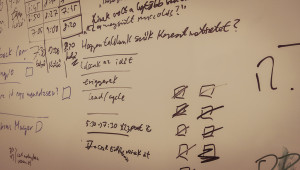
AGILE FOR MANAGERS
This course is recommended for those managers, who have not yet met with agility and its basics. Furthermore, for those managers as well, who dealt with agility and now they want to update or expand their knowledge. It is an optimal basic and concept clarifying training for leaders who are using individual agile coaching.
WHAT DOES IT CONTAIN?
- The historical background of agility
- Introduction to agility
- Agile manifesto
- Agile principles
- Lean principles
- Lean wastes in software development
- Kanban in software development
- Kanban board types
- The Scrum framework
- Scrum roles
- Scrum pifalls with practical examples
- The agile organization
- The agile organizational transformation
- Real world software Kanban examples
- Real world Scrum examples
- Final exam
WHAT WILL YOU LEARN?
- Understand the philosophy behind agile
- Understand the evolution of software development methods
- Understand why agile and lean trending
- Learn how to be “more” agile and how to improve yourself and your team
- Understand the nature of wastes in software development
- Learn the Role of an Agile Manager and the expectations
- Brainstorm and discuss common challenges with this role transition
- Learn top ways and models other companies have used to address challenges
- Understand why Servant Leadership and Facilitation skills are critical to success
- Learn key skills needed for People Development and Coaching
- Learn key skills needed for Process Improvement
- Understand boundary and flexibility of agile
- Learn how widely a Kanban board can be used
- Learn real world implementations of Kanban and Scrum
- Learn real world challenges
- Develop a clear change management plan for this role transition
RECOMMENDED BACKGROUND
This course requires project management or overall management experience and theoretical basics. Software development background is not a must, however it could be useful. Team leading background or change management background is an advantage.
Attendees typically include Product Directors, Lean-Agile Leaders, PMO, Project Managers, Team Leaders.
SUGGESTED READINGS
Agile Project Management For Dummies cheat sheet Read
The Manager’s Role in Agile Read
5 Agile Project Management Techniques You Can Start Using Today Read
The Integration of Agile and the Project Management Office Read
Why We Fail to Change: Understanding Practices, Principles, and Values Is a Solution Read
The Role of Project Managers in Agile Read
Adopting Agile When Your Management Style is Mostly Command and Control Read
The Role of the Middle Manager in an Agile World Read
InfoQ eMag: Agile Project Management Read
COURSE FORMAT
- classroom training
- max. 8 person / group
- 3×8 hours
TOOLS NEEDED
- 2 magnetic whiteboards
- flipchart
- projector
PRICING
- Pricing model: price per person.
FAQ
- What is different about this course?
This course is a special overview of agile techniques, methods and practices for managers who support agile transformations on an easily understandable way. The main purpose of this program is to give a clear view of the whole agile area as quick as possible.
- What are people saying about this course?
“We had an experienced instructor, and after taking the agile management course, I was able to share the principles of the agile methodology with my team. Furthermore I have got a vision how could be our work more organized.”
- What is the coolest thing I’ll learn if I take this course?
The hit point of this course is that as an agile transformation supporter and manager I know how the different agile areas and parts are connected. I saw how a well made agile implementation works and I know how an agile organization works.
PICTURES FROM CLASS
Our training defines a clear picture how to deliver business-valued software to your customer in less time. We learn how to develop higher-quality software products at lower cost and how to mitigate uncertainty and risk by applying Agile values and principles. We show examples applying the Scrum framework to meet business needs and focusing on continuous process improvement through embedded learning in the workplace.
Come with an open mind! We guarantee that you will learn creative methods you can apply immediately!






